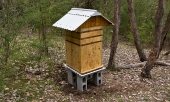
 2
2





Urban solutions using permaculture ethics? Providing promotional support to practitioners and consultants, https://www.prosperityhomestead.org/








Patrick Mann wrote:What is the advantage of this circle planting? Seems like at least one of the trees would be shaded out.
 2
2




Patrick Mann wrote:What is the advantage of this circle planting? Seems like at least one of the trees would be shaded out.

Urban solutions using permaculture ethics? Providing promotional support to practitioners and consultants, https://www.prosperityhomestead.org/




"You keep using that word. I do not think it means what you think it means."









Urban solutions using permaculture ethics? Providing promotional support to practitioners and consultants, https://www.prosperityhomestead.org/




Brenda
Bloom where you are planted.
http://restfultrailsfoodforestgarden.blogspot.com/
 2
2








Jae eaj wrote:I have a circle of fruit trees with a little pond in the center. Mine is a little wider than yours.
Urban solutions using permaculture ethics? Providing promotional support to practitioners and consultants, https://www.prosperityhomestead.org/





 1
1






 2
2




![Filename: pole_apples_columnar_apples.jpg
Description: [Thumbnail for pole_apples_columnar_apples.jpg]](/t/19109/a/7344/pole_apples_columnar_apples.jpg)
![Filename: Carbohydrateestimationincolumnar.jpg
Description: [Thumbnail for Carbohydrateestimationincolumnar.jpg]](/t/19109/a/7345/Carbohydrateestimationincolumnar.jpg)
![Filename: 2527104484_3132a48efc.jpg
Description: [Thumbnail for 2527104484_3132a48efc.jpg]](/t/19109/a/7346/2527104484_3132a48efc.jpg)








 1
1




Saybian Morgan wrote:Am I correct in considering the fruit tree circle to be an adaptation of the banana circle system. If so it's only appropriate to certain tree growth pattern types, it's not the shading out that's the issue but the tangling and stunting of one another via shading. In the case of a palm let's say the tree's race each other upwards and resolve the spacing with each other via their mono stemlike nature. It doesn't work with tree's that unpruned would naturally form a cone, but I can tell you a willow coppice circle hasg some serious advantages.
Aside from the risk of pioneering I say go for it for better or worse as someone defied conventional thinking when the banana circle was invented. You may not hit it with one type of fruit tree, then score a big one for all of us with another.
Subtropical desert (Köppen: BWh)
Elevation: 1090 ft Annual rainfall: 7"





|
Please do not shoot the fish in this barrel. But you can shoot at this tiny ad:
The new purple deck of permaculture playing cards
https://www.kickstarter.com/projects/paulwheaton/garden-cards
|






